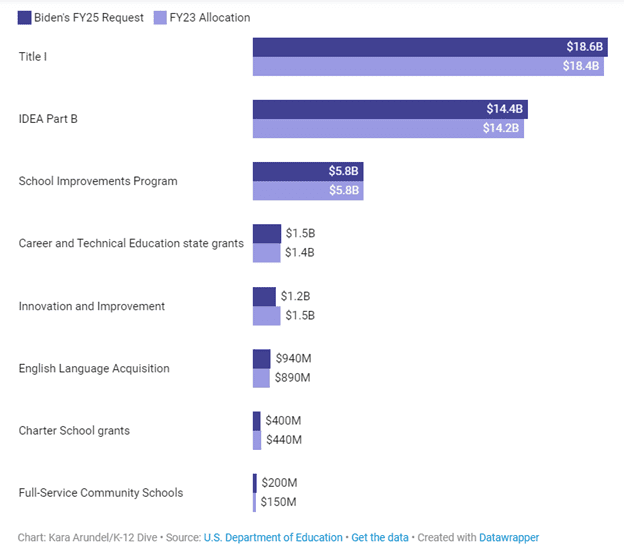
Biden proposes 3.9% FY 2025 increase for Education Department
K12 Dive | By Kara Arundel | March 11, 2024
The Biden administration is proposing a 3.9% increase over fiscal 2023 for the U.S. Department of Education, for a total of $82 billion in discretionary funding for early learning, K-12 and higher education in its fiscal year 2025 budget released Monday.
The requested amount is modest compared to the 41% increase sought for FY 2022 over FY 2021 allocations and the 15.6% increase recommended for FY 2023 compared to FY 2022. For FY 2024, Biden had asked for a 13.6% increase over FY 2023 spending levels.
Education proposals touted by the White House include a guarantee of high-quality child care at a cost of no more than $10 a day for the vast majority of families and an expansion of tutoring, after-school and summer programs. The budget also calls for investments aimed at easing teacher shortages.
To emphasize the continuing need to catch students up academically from pandemic-related setbacks, the White House is proposing a new Academic Acceleration and Achievement grant program at $8 billion. While details are still being developed, it’s expected to be a competitive program for states and districts to support and sustain learning interventions developed with COVID emergency funds, particularly for students with the highest needs.
“There are historic investments here requested on top of historic investments delivered,” U.S. Education Secretary Miguel Cardona said during a Monday press call.
Although Congress has yet to finalize a FY 2024 budget for the Education Department and House Republicans have warned they want to lower spending across federal agencies, Cardona said the proposed budget “unapologetically strives to raise the bar for education in America and position our nation to lead the world for years to come.”
Biden’s FY 2025 proposal vs. FY 2023 allocations
The Education Department’s proposed budget represents a 3.9% increase over FY 2023 allocations for a total of $82 billion.

The proposed budget includes $18.6 billion for Title I to support high-poverty schools. That represents a $200 million increase over FY 2023 spending, but it is significantly lower than the $36.5 billion Biden sought for FY 2024.
For special education services for school-aged students with disabilities, the Biden administration recommends $14.4 billion, or a $200 million increase from FY 23. Also proposed is $545 million for state grants, or $5 million more than FY 2023, under the Individuals with Disabilities Education Act for services to infants and toddlers with disabilities.
Although annual federal appropriations for education spending typically account for less than 10% of all K-12 funding, states and districts collectively received $189.5 billion in COVID-19 emergency allocations since the pandemic’s onset in March 2020.
With spending on the last and largest of that aid coming to a halt early next year, state and local education leaders are planning to transition back to a more typical budget cycle. For some localities, particularly those with more high-poverty schools, that switch will be more challenging, researchers have predicted.
Additional education-related spending requests include:
- Teacher recruitment and retention. The budget proposes $90 million for Supporting Effective Education Development, $95 million for the Teacher Quality Partnership program, and doubling of funding to $30 million for the Hawkins Centers of Excellence program to expand the number of prospective teachers with access to high-quality pathways and improve the diversity of the teacher pipeline. The budget also calls for $173 million for the Teacher and School Leader Incentive Fund.
- Early learning. The budget recommends voluntary free preschool for all 4 million 4-year-olds and would chart a path to expand preschool to 3-year-olds. The proposed budget also includes $25 million for school readiness through the Preschool Incentive Demonstration Program. High-quality preschool would be offered in the setting of the parent’s choice — from public schools to child care providers to Head Start. Under the proposed plan, Head Start would receive $12.5 billion, up $544 million from FY 2023.
- Social, emotional and mental health supports. The White House recommends $216 million for mental health programs in K-12 schools, including $200 million from the Bipartisan Safer Communities Act. These funds, the Biden administration said, would increase the number of school-based counselors, psychologists, social workers and other mental health professionals in K-12 schools.
- Charter school grants. This program would see a $40 million decrease, to $400 million. During the press call, officials said the FY 2025 proposed budget includes a handful of decreases due to funding constraints under the Fiscal Responsibility Act.
- Multilingual supports. The Biden administration wants to boost funds for the English Language Acquisition program by $50 million, bringing it to $940 million. The budget proposes $72 million to help schools hire more bilingual teachers and for professional development on multilingual education for existing teachers and staff.
- Office for Civil Rights. The budget recommends funding the Education Department’s Office for Civil Rights at $162 million, a $22 million increase above FY 2023 levels, to add enforcement staff.
Budget limbo
While politicians, policymakers and advocates gave their attention Monday to the unveiling of President Joe Biden’s FY 2025 budget, many are also focused on the unfinished work of finalizing the current year allocations.
FY 2024 began Oct. 1. After four continuing resolutions, Biden signed an appropriations bill Friday to fund several agencies. The remaining agencies — including the Education Department — are still running on a continuing resolution that expires March 22.
It wasn’t supposed to be this complex. Last June, the Biden administration, the Republican-led House and the Democrat-led Senate agreed to flat-fund education in FY 2024 as part of a deal to prevent the nation from defaulting on its debt. That deal also limited nondefense spending, including for education, to a 1% increase for FY 2025.
But shortly after that agreement, Republicans on the House Appropriations Committee recommended an 80% spending cut to Title I funds. The lawmakers attributed that move to underspending on COVID emergency funding and a desire to eliminate duplicative and underperforming programs.
“The slash and burn approach to education budgets that others have called for, especially at the federal level, if it had been enacted, would have been a deep and self-inflicted wound to American leadership,” Cardona said during Monday’s press call.
The threat to Title I mobilized educators and advocates who said the cut would result in 220,000 fewer classroom teachers and drastic reductions in other education programs.
Looking forward to FY 2025, GOP House leaders have already said they will “sound the alarm” on what they call “already bloated” spending levels and “out of control” debt levels.
In a statement Monday, the White House said the deficit grew by $2 trillion under former President Donald Trump when he signed a bill providing tax cuts for the wealthy and large corporations. Biden’s FY 2025 plan proposes to reduce the deficit by roughly $3 trillion over the next 10 years by “making the wealthy and large corporations pay their fair share, closing tax loopholes, cutting wasteful spending on Big Pharma, Big Oil, and other special interests,” according to a White House statement.





